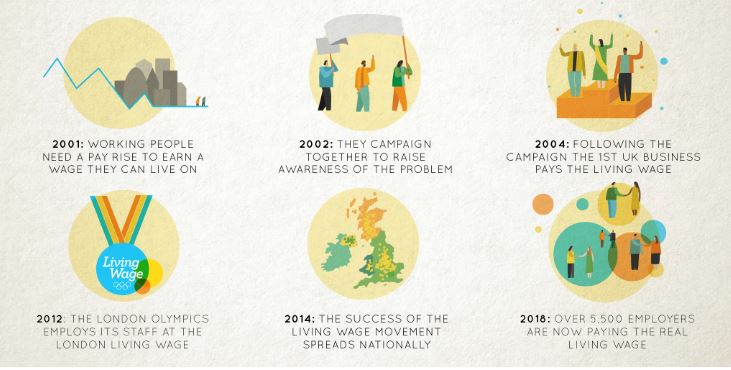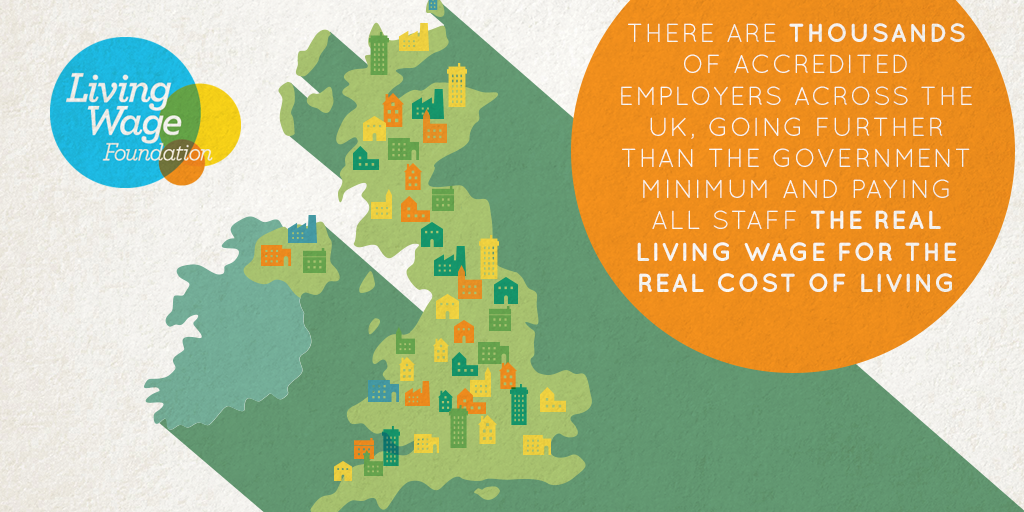It’s Living Wage Week, all companies in the APG Group are Living Wage Employers so we’re joining the celebrations of the Living Wage Movement! The Living Wage network has benefitted 93% of businesses, to show our support and commitment to the Living Wage campaign we’ve created a guide on the need to know of Living Wage Week and the Living Wage Foundation.

Who is the Living Wage Foundation?
The Living Wage Foundation was established in 2011 and grew from a Living Wage Campaign, launched in 2001 by members of London Citizens, which has since become the nationwide institution Citizens UK.
They are at the heart of an independent movement campaigning for a fair day’s pay for a hard day’s work, celebrate employers who choose to go further and pay a real Living Wage based on the real cost of living. The campaign for a real Living Wage has delivered 1 billion in extra wages to workers since 2001 and has lifted over 200,000 people out of in-work poverty.
The Foundation provides advice and support to employers and service providers implementing Living Wage rates. It accredits employers that commit to the Living Wage rates and a Service Provider Recognition Scheme for third party contractors ensuring they are earning the real Living Wage. The Living Wage Week is coordinated for every November.
What is the Living Wage?
The Living Wage independently calculated by the Living Wage Foundation based on the cost of living which employers can choose to voluntarily pay. The Foundation encourages employers that can afford to do so, to allow their employees to earn a wage that truly covers what they need to live.
Over 5,000 UK employers are paying the Living Wage.

What do Current Statistics Say About the Living Wage?
- Less than one-fifth (19%) of UK jobs pay below the real Living Wage threshold, down 22% from 2018. This is the lowest figure in seven years and represents a decrease of around 560,000 jobs paying less than the real Living Wage.
- The number of jobs paid less than the real Living Wage is now estimated at 5.19 million. However, 38% of part-time jobs earn less than the real living wage compared to 12% for full-time employees.
- The proportion of female employees earning less than the real Living Wage is 24% which is higher than 15% of men. This equates to around 3.2 million female employees in ratio to 2 million males.

What’s the Difference between the Living Wage and the Government’s National Living Wage?
The Government’s statutory minimum wage for over 25’s is known as the ‘National Living Wage’, it is separate to the Living Wage Foundation. It is calculated not on the cost of living, but a target to reach 60% median earnings by 2020.
Full-time workers earning the Living Wage Foundation’s Living Wage earn about £2,540.50 a year more than those on the Government’s National Living Wage in the UK and £4563 in London.

Who Should Receive the Living Wage?
The Living Wage applies to all directly employed staff over 18, regardless of the number of hours they work.
For third party contractors, it applies to those who regularly work 2 or more hours a week for 8 or more consecutive weeks a year. Contractors supplying your organisation with products are exempt e.g. stationary.
Communicate your commitment to the Living Wage to everyone you do business with and encourage them to implement it.

What is Included in the Living Wage Rates?
The Living Wage doesn’t include any non-cash goods, only guaranteed non-deferred payments are counted towards it. Employer pension contribution do not form part of the Living Wage, because of this. Guaranteed bonuses are included but non-guaranteed bonuses for productivity or sales are not, except in specific cases where the hourly wage is definite.

When do the New Living Wage Rates Have to be Implemented?
The 2019/2020 rates will be announced on the 11th November 2019. Employers should implement the rise within 6 months. Employees should be receiving the new rates by 11th May 2020.

How Do You Become Accredited?
To become an accredited employer, you must fill in the enquiry form. The Living Wage Foundation will send an online licence form and a guide to implement the Living Wage. Your organisation must satisfy accreditation requirements before submitting the form.
The Foundation aims to process accreditations within ten working days, but it depends on how many accreditations they’re processing, organisation’s size and the types of contracts you have. It can take six months to accredit larger organisations.
The cost also varies according to the organisation’s size, starting at £60 per year for fewer than 10 employees. You can find out the cost via the enquiry form.

The Benefits of being a Living Wage Employer
Recruitment and Retention
With a Living Wage accreditation, 75% of employers see improved retention of staff and quality of applicants for jobs. Paying the Living Wage also reduces the spend on recruitment, as well as the time and training required to build skills and experience for a role. The accreditation also makes organisations more attractive to graduates and higher qualified employees, with 93% of university graduates wanting to work for a Living Wage Employer.

Valued Employees are Valuable
By simply fulfilling a legal obligation and paying minimum wage, it’s not sending the right message to your employees. The Living Wage encourages a positive work atmosphere and ensures your employees have the means to live a fuller life, 86% of businesses agree since accrediting their staff motivation has increased. Happier employees are more loyal to employers, take fewer days absence and care more about their work.

Community and Consumer Reputation
Through the implementation of the Living Wage, 86% of employers have reported reputational benefits through consumer awareness of their ethical commitment to staff. This enhanced reputation can aid organisations when bidding for public service contracts and 64% of employees agree it’s helped to differentiate themselves from others in the same industry.

Be Competitive
Employers are now competing for staff in a market where the Living Wage is increasingly common, with Barclays, HSBC and Nestle being just some of the household Living Wage employers. The Living Wage accreditation creates a stronger ‘employer brand’ and a competitive advantage against similar organisations. It has helped the organisation secure public and private contracts, secure funding and raised the quality of what they can provide.

Quality Customer Service
Living Wage employers see higher customer satisfaction and fewer complaints, especially in the retail and leisure sectors. This is also a result of employee productivity and motivational improvements using up-skilling programmes to link the level of training to the Living Wage.

Multiplier Effect
Because of how the Living Wage is calculated, employees will see an increase in disposable income. Lower-income workers receiving higher pay are more likely to spend than save, meaning businesses paying the Living Wage will benefit from increased spending power.
Those companies that have introduced a Living Wage ahead of peers are more likely to see greater benefits short term. It’s important that Living Wage becomes standard practice and employers differentiate themselves in other ways like utilising up-skilling.

Satisfy the Millennials
By 2020, it’s predicted half the workforce will be millennials and as the generation matures, they will take many of the senior roles, making key business decisions. Millennials are notoriously driven by a strong moral compass, caring deeply about the ethicality of organisations. As a Living Wage employer, you will be able to align with their values and get ahead of the everchanging workforce.
For more details see the Living Wage Foundation’s FAQ page or contact them if you can’t find the answer to your question.
If you’re ready to become a Living Wage employer, you can find out more here.

About APG
The Asset Protection Group comprises a group of Fire & Security companies with shared ownership and one common goal, protecting your most important assets. As a collective group, we look to offer protection to your assets to assist you with your ongoing success within your own business.

